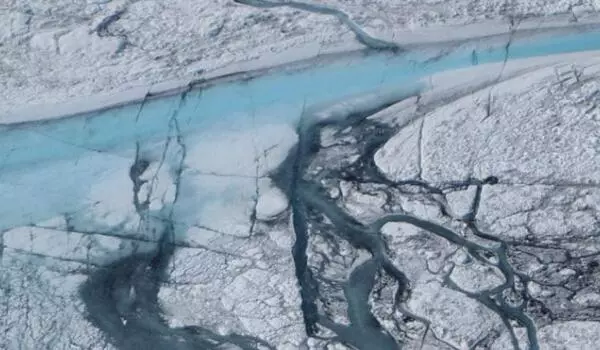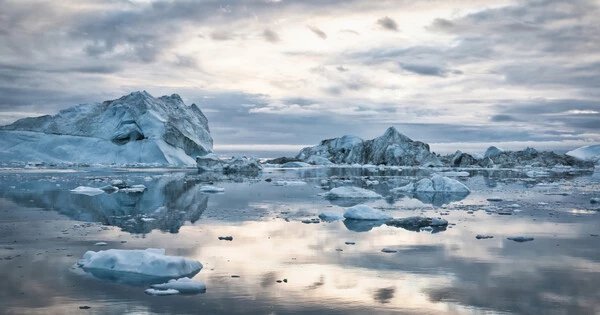The Greenland Ice Sheet is one of the largest ice sheets in the world and contains enough ice to raise global sea levels by about 7 meters if it were to completely melt. Research has shown that the ice sheet is melting at an increasing rate, and if this continues, it could reach a point of no return, where it would continue to melt even if global temperatures were to stabilize.
A new simulation-based study identified two tipping points for the Greenland Ice Sheet: releasing 1000 gigatonnes of carbon into the atmosphere will cause the southern portion of the ice sheet to melt; releasing about 2500 gigatonnes of carbon will result in the permanent loss of nearly the entire ice sheet. We’re about halfway to the first tipping point, having emitted about 500 gigatonnes of carbon.
In the Arctic, the Greenland Ice Sheet covers 1.7 million square kilometers (660,200 square miles). If the ice sheet completely melts, global sea level will rise by about 7 meters (23 feet), but scientists are unsure how quickly the ice sheet will melt. Modeling tipping points, or critical thresholds at which a system’s behavior irreversibly changes, assists researchers in determining when that melt might occur.
Based in part on carbon emissions, a new study using simulations identified two tipping points for the Greenland Ice Sheet: releasing 1000 gigatons of carbon into the atmosphere will cause the southern portion of the ice sheet to melt; about 2500 gigatons of carbon means permanent loss of nearly the entire ice sheet.
The first tipping point is not far from today’s climate conditions, so we’re in danger of crossing it. Once we start sliding, we will fall off this cliff and cannot climb back up.
Dennis Höning
Having emitted about 500 gigatons of carbon, we’re about halfway to the first tipping point.
“The first tipping point is not far from today’s climate conditions, so we’re in danger of crossing it,” said Dennis Höning, a climate scientist at the Potsdam Institute for Climate Impact Research who led the study. “Once we start sliding, we will fall off this cliff and cannot climb back up.”
The study was published in AGU’s journal Geophysical Research Letters, which publishes short-format, high-impact research spanning the Earth and space sciences. The Greenland Ice Sheet is already melting; between 2003 and 2016, it lost about 255 gigatons (billions of tons) of ice each year. Much of the melt to date has been in the southern part of the ice sheet. Air and water temperature, ocean currents, precipitation, and other factors all determine how quickly the ice sheet melts and where it loses ice.

The complexities of how those factors interact, combined with the long timescales scientists must consider when melting an ice sheet of this size, make it difficult to predict how the ice sheet will respond to various climate and carbon emissions scenarios. Previous research identified 1 to 3 degrees Celsius (1.8 to 5.4 degrees Fahrenheit) global warming as the threshold beyond which the Greenland Ice Sheet will melt irreversibly.
Höning’s new study used a complex model of the entire Earth system, which includes all of the key climate feedback processes, paired with an ice sheet behavior model for the first time to more comprehensively model how the ice sheet’s response to climate could evolve over time. They began by simulating the ice sheet at constant temperatures to find equilibrium states, or points where ice loss equaled ice gain. The researchers then ran a series of 20,000-year simulations with carbon emissions ranging from 0 to 4000 gigatonnes.
The researchers derived the 1000-gigaton carbon tipping point for the melting of the southern portion of the ice sheet and the even more perilous 2,500-gigaton carbon tipping point for the disappearance of nearly the entire ice sheet from those simulations.
As the ice sheet melts, its surface will become lower and lower, exposing it to warmer air temperatures. Warmer air temperatures hasten melt, causing it to drop and warm further. For this feedback loop to be effective, global air temperatures must remain elevated for hundreds of years or longer; a quick blip of 2 degrees Celsius (3.6 degrees Fahrenheit) would not trigger it, according to Höning. However, once the ice passes through the threshold, it will inevitably continue to melt. Even if atmospheric carbon dioxide were reduced to pre-industrial levels, it wouldn’t be enough to allow the ice sheet to regrow substantially.
“We cannot continue carbon emissions at the same rate for much longer without risking crossing the tipping points,” Höning said. “Most of the ice sheet melting won’t occur in the next decade, but it won’t be too long before we will not be able to work against it anymore.”
















